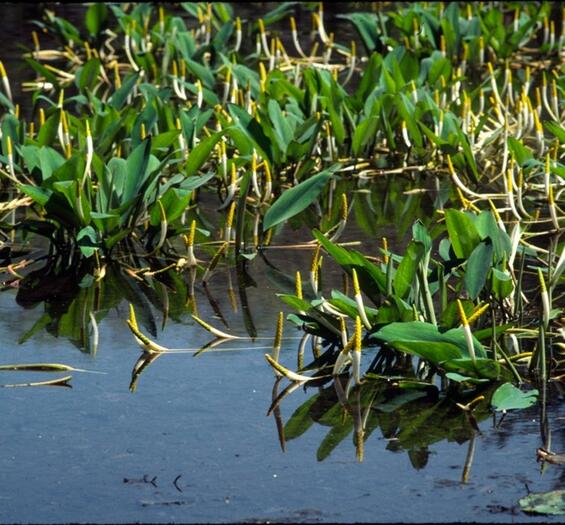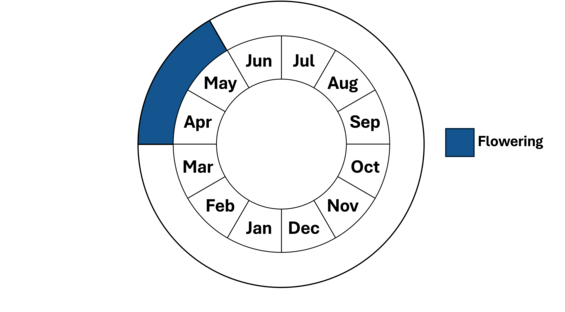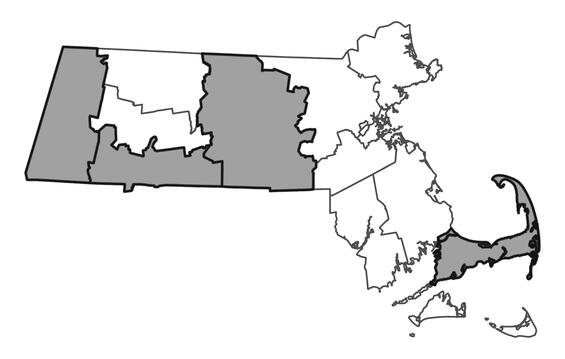- Scientific name: Orontium aquaticum
- Species of Greatest Conservation Need (MA State Wildlife Action Plan)
- Endangered (MA Endangered Species Act)
Description

Golden Club (Orontium aquaticum)
Golden club is an aquatic perennial with long, golden-tipped, white-stemmed flowering stalks. This member of the predominately tropical arum family (Araceae) is found in the shallow water of ponds, bogs, and slow-moving rivers.
Golden club has blue-green, 13-30 cm (5-12 in) long leaves that are long-stemmed, oblong-elliptic, and entire. The upper leaf surfaces have a sheen and veins are prominent. Golden club has stout rhizomes that are deeply sunken in the substrate. When growing in water, its leaves often float, but if the plant is exposed, they are erect. As its name implies, golden club has a golden-yellow, club-like inflorescence (spathe) with female flowers occurring at the base and male flowers at the tip. Plants flower in April and May. After flowering, the flower stems arch over so that the flowering tip is completely under water during fruit production. Fruits are blue-green berries that ripen by mid-June and are fully dispersed by the end of August.
Pickerelweed (Pontederia cordata) is superficially similar in that it grows in a similar habitat and has large, long-stalked leaves. However, pickerelweed has heart-shaped leaves and violet-blue flowers. In Massachusetts, it has been observed that pickerelweed is absent from ponds where golden club occurs and vice versa.
Life cycle and behavior

This is a perennial species.
Population status
Golden club is currently listed as endangered in Massachusetts. As with all species listed in Massachusetts, individuals of the species are protected from take (picking, collecting, killing) and sale under the Massachusetts Endangered Species Act. Fourteen current stations of golden club are known in the Commonwealth. The Massachusetts Natural Heritage & Endangered Species Program has 30 records from 5 counties: Barnstable, Berkshire, Hampden, Hampshire, and Worcester. Seven of these records have been observed within the last 25 years. The rarity of golden club in Massachusetts is in part due to the state’s location at the northern extent of the species range; however, golden club’s decline within the state is due to a loss of habitat from pond shore development and subsequent changes in water levels and water and substrate quality. Despite the loss of most historical populations, golden club is considered relatively secure in the Commonwealth due to the active protection of populations by the Department of Conservation and Recreation, the Cape Cod National Seashore, and the U.S. Army Corps of Engineers.

Distribution in Massachusetts. 1999-2024. Based on records in the Natural Heritage Database.
Distribution and abundance
The documented range of golden club extends from Massachusetts to Louisiana, primarily along the coastal plain. Plants occur locally in central New York, West Virginia, and Kentucky.
Habitat
Golden club prefers silty, muddy, or peaty bottoms in the shallow water of ponds, bogs, marshes, and slow rivers. Specific habitats in Massachusetts include the zone of shallow water (<0.5 m deep; 2 ft deep) of a small kettlehole pond with fragrant water-lily (Nymphaea odorata), bullhead-lily (Nuphar variegata), water-shield (Brasenia schreberi), pondweed (Potamogeton sp.), and bladderwort (Utricularia sp.); shallow ponds between sand dunes in oak-beech forest where it occurs as virtually the only aquatic plant; and on the sphagnum mat of an acid beech forest where it occurs as virtually the only aquatic plant; and on the sphagnum mat of an acid bog with leatherleaf (Chamaedaphne calyculata), sweet gale (Myrica gale), sheep-laurel (Kalmia augustifolia), pitcher-plant (Sarracenia purpurea), and young white pine (Pinus strobus). The acid bog site is the northernmost locality of golden club in New England, and it is unusual habitat for a species that typically occurs in shallow ponds.
Healthy habitats are vital for supporting native wildlife and plants. Explore habitats and learn about conservation and restoration in Massachusetts.
Threats
Golden club has specific water level requirements; it is typically found in shallow ponds in water levels up to 0.3-0.5 m (1.5-2 ft) deep. Population declines and loss of plant vigor (i.e., absence of flowering stalks) have been observed both with increases and decreases in water level. Increases in water level may prevent seedling establishment, while decreases may prevent flower development and successful seed dispersal. Pond eutrophication (nutrient enrichment) due to runoff from landfills and agricultural fields negatively impacts golden club by increasing algal growth and by increasing organic matter accumulation in the substrate. Canada geese browse golden club’s young shoots and pose a potentially serious threat due to their growing numbers.
Conservation
As for many rare species, the exact needs for management of golden club are not known. The following comments are based primarily on observations of populations in Massachusetts. Raising or lowering of water levels in ponds in which golden club occurs should be avoided. Golden club grows in open habitats; selective cutting and removal of tall, shrubby plants such as leatherleaf and sweet gale can favor golden club populations. Management techniques to reduce Canada geese numbers in areas where golden club occur would benefit this rare species.
Contact
| Date published: | May 9, 2025 |
|---|